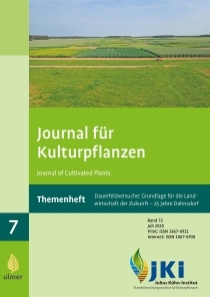Crop rotation versus monoculture: Economic analysis of long-term (18 years) field trials in rye
DOI:
https://doi.org/10.5073/JfK.2020.07.07Keywords:
long-term field trials, economic evaluation, rye production, legumes, direct- and labour cost free revenuesAbstract
A diverse crop rotation with legumes may provide economic advantages for agriculture due to their positive pre-crop effects. In most cases, economic evaluations only take single main crops into account. Here, an economic evaluation of the entire crop rotation is presented, which was based on three rotations over a period of 18 years. We assessed a long-term field trial on impact assessment of crop rotation, fertilization and plant protection performed at JKI-field site in Dahnsdorf economically based on the direct and labor cost-free revenues as well as net present values and annuities. Permanent rye cultivation and a crop rotation with six components including barley and rye, diversified with pea and white clover were compared.
Yield increases of barley and rye following legumes had decisive influence on the economic result as well as the use opportunity of clover (green manure). Costs of plant protection and fertilization remained almost the same over the years. The cultivation of rye after peas in crop rotation was economically most advantageous in all tested variants. The comparison of the long-term cultivation of rye with the varied crop rotation showed, however, that with appropriate fertilizer and crop protection measures, the long-term cultivation was even more successful.
With respect to societal and political demands for reducing pesticide and fertilizer use, future recommendations for farming strategies should take into account the economic viability of extended crop rotations with legumes. The economic advantage of crop rotations significantly increased over the years and rotations.
Downloads
Published
Issue
Section
License
The content of the journal is licensed under the Creative Commons Attribution 4.0 License. Any user is free to share and adapt (remix, transform, build upon) the content as long as the original publication is attributed (authors, title, year, journal, issue, pages).
The copyright of the published work remains with the authors. The authors grant the Journal of Cultivated Plants, the Julius Kühn-Institut and the OpenAgrar repository the non-exclusive right to distribute and exploit the work.







